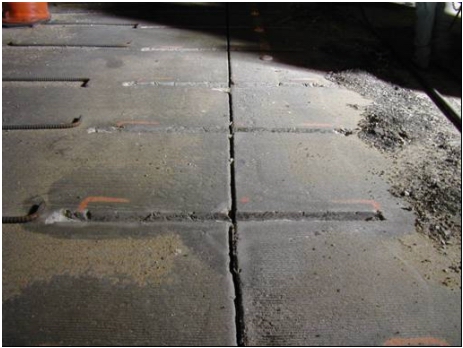Stitching is a rehabilitation technique used at cracks to maintain aggregate interlock and provide added reinforcement to minimize the relative movement of concrete slabs at the cracks. It is also used at the longitudinal joints to keep the slabs from separating.
Pavement distresses that require stitching
In CPCD, cracks are not intended and could cause performance problems. Examples include transverse and longitudinal cracks. From a pavement distress standpoint, transverse cracks are more serious than longitudinal ones, because wheel loads are applied to both sides of the crack in succession. Under heavy truck traffic, there is a differential movement at the crack and it deteriorates rather quickly. The normal practice to repair slabs with transverse cracks is to remove and replace. Stitching transverse cracks in CPCD will cause stress buildup somewhere else from the volume changes due to temperature variations and result in new cracks or spalls. Stitching should never be used at transverse cracks in CPCD. On the other hand, longitudinal cracks in CPCD do not necessarily deteriorate at the same rate as transverse cracks and do not need to be removed and replaced. For some longitudinal cracks, simple sealing is all that’s required. For some other longitudinal cracks, stitching might be a good repair option. It depends on the location of the longitudinal cracks.
In CRCP, the only time stitching is utilized is where lanes are separating at the longitudinal joints. In CRCP, the integral transverse and longitudinal reinforcement hold cracks tight preventing further pavement distress, unless longitudinal cracks extend through the full slab depth, rupturing the steel. In that case, punchouts will result and FDR is the most appropriate repair option.
Tie bars at construction joints (for both CPCD and CRCP) and transverse steel at warping joints (for CRCP) are used to keep the lanes from separating. However, for various reasons, lanes do separate at longitudinal joints, primarily longitudinal construction joints. Construction errors and steel deterioration can result in lane separation. Lane separations as much as 2 inches or more have been observed. The negative effect of lane separation is that, in addition to the safety hazard to motorcycles, load transfer to the next lane is not achieved, and the slab will be subject to edge loading, rather than interior loading conditions. The edge loading condition causes higher wheel load stresses than interior loading conditions do, and will reduce the fatigue life of concrete, impacting pavement performance by initiating longitudinal and/or corner cracks in CPCD and punchouts in CRCP.
Types of Stitching
There are three types of stitching used; cross-stitching, slot-stitching, and U-bar stitching. Cross-stitching is the most widely used method.
In cross-stitching, holes are drilled at an angle so that they intersect the longitudinal cracks or joints at about mid-depth of the slab. Drilling dust is removed by compressed air and epoxy is injected into the holes. Tie bars are inserted and excess epoxy is removed.
In slot-stitching, slots with lengths no smaller than 25 inches are cut approximately perpendicular to the longitudinal joints or cracks using a slot cutting machine or walk-behind saw. Slots are prepared by removing the concrete and cleaning the slot. Deformed bars are placed and backfill material is applied, finished, and cured. In slot-stitching, the concrete slabs are held together by the shear stress of deformed bars. It is important to provide high strength backfill material and good consolidation around the bars and concrete slot surfaces.
In U-bar stitching, slots are cut using a slot cutting machine and concrete is broken and removed by pneumatic hammer. Figure 1 shows the slots and U-bars. In this method, anchoring action by the U-bars provides most of the restraining force. Proper backfilling around the ends of the U-bars is important.

Among these three methods, there is not enough field performance information to judge their relative performance. A research study will be conducted on the effectiveness of these methods and this section will be updated as findings become available.
References
Original article content and pictures contributed by TxDOT.
